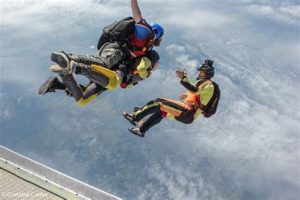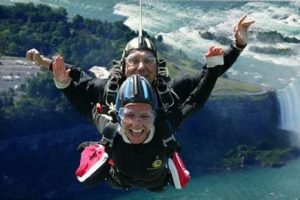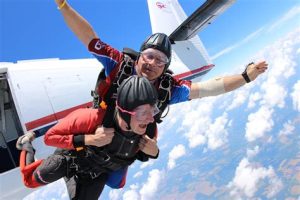Table of Contents
Curious about the speed at which tandem skydivers plummet through the air? Discover how quickly tandem skydivers fall and experience the exhilarating rush of freefalling from dizzying heights. Learn about the factors that influence their descent speed and the safety measures in place to ensure a thrilling yet secure skydiving experience.
Have you ever wondered how fast tandem skydivers fall from the sky? Strap yourself in and get ready to learn about the incredible speed at which these daredevils plummet towards the earth. Brace yourself for a thrilling ride through the world of extreme sports as we delve into the science behind their rapid descent. So, what exactly determines how quickly tandem skydivers hurtle towards the ground? Let’s dive in and find out!
Introduction
Welcome to this guide on how fast tandem skydivers fall! If you’ve ever wondered about the exhilarating experience of skydiving and how fast you’ll be hurtling towards the ground, you’ve come to the right place. In this article, we will explore the factors influencing the speed at which tandem skydivers descend, providing you with a better understanding of this thrilling adventure.
The Basics of Tandem Skydiving
Tandem skydiving involves two individuals: the student and an experienced instructor who is attached to the student during the jump. The instructor guides and controls the entire skydiving process, ensuring a safe and enjoyable experience for both individuals.
Gravity: The Driving Force
When it comes to skydiving, gravity is the primary force responsible for the descent. As the saying goes, what goes up must come down. The force of gravity pulls the tandem pair towards the ground, accelerating their fall until the parachute is deployed.
Terminal Velocity
Terminal velocity refers to the maximum speed at which a falling object can travel through the air. It occurs when the force of gravity pulling the skydivers downwards is balanced by the resistance from the air pushing against them. Terminal velocity is achieved when the downward force and air resistance are equal, resulting in a constant speed.
Factors Affecting Terminal Velocity
Several factors influence the terminal velocity of tandem skydivers:
1. Body Position
The body position of the skydivers greatly affects their terminal velocity. A streamlined position, with arms and legs close to the body, reduces air resistance and allows for faster descent.
2. Weight and Surface Area
The weight and surface area of the tandem pair also impact their terminal velocity. A heavier pair will fall faster, while a larger surface area (such as a drogue parachute) increases air resistance, slowing the descent.
3. Altitude
The altitude at which the tandem jump takes place affects the time available for acceleration. Higher altitudes provide more time for acceleration, resulting in a higher terminal velocity.
The Speed of Descent
On average, tandem skydivers reach speeds of around 120 mph (193 km/h) during freefall. However, the actual speed can vary depending on various factors, including those mentioned above. The excitement and thrill of freefalling at such incredible speeds are what make skydiving an unforgettable experience.
The Role of the Parachute
Once the tandem pair reaches a predetermined altitude, typically around 5,000 feet (1,524 meters), the instructor deploys the parachute. The deployed parachute significantly reduces the speed of descent, ensuring a safe landing.
Canopy Descent Speed
After the parachute is deployed, the speed at which the tandem skydivers descend reduces dramatically. The canopy descent speed is much slower, usually around 10 to 14 mph (16 to 23 km/h), allowing for a controlled and gentle landing.
Conclusion
Tandem skydiving provides an incredible opportunity to experience the thrill of freefalling through the sky. While the speed of descent can vary based on factors such as body position, weight, altitude, and parachute deployment, the average speed during freefall is around 120 mph (193 km/h). So, if you’ve ever dreamt of soaring through the air at incredible speeds, tandem skydiving is an adventure you won’t want to miss!
How Fast Do Tandem Skydivers Fall: A Step-by-Step Guide
Welcome to our step-by-step guide on understanding how fast tandem skydivers fall. In this guide, we will break down the different factors that influence the speed of descent during a tandem skydiving experience.
Understanding Terminal Velocity
Terminal velocity refers to the constant speed at which a skydiver falls when the upward force of air resistance equals the downward force of gravity. Tandem skydivers experience a terminal velocity range of approximately 120 to 150 miles per hour (193 to 241 kilometers per hour) during freefall.
Body Positioning
Body positioning plays a crucial role in determining the speed of descent. Tandem skydivers are advised to maintain a stable and streamlined position, with arms and legs slightly bent and relaxed. This minimizes air resistance and allows for a smoother, faster descent.
Parachute Deployment
Once the parachute is deployed, the descent speed decreases significantly. At this point, the tandem skydivers usually experience a vertical speed of around 15 to 20 miles per hour (24 to 32 kilometers per hour). The parachute slows down the fall gradually, providing a gentle and controlled descent.
Altitude and Air Density
The altitude and air density also impact the speed of tandem skydivers during their descent. As the altitude increases, the air density decreases, resulting in a slightly higher terminal velocity. However, the difference is minimal and not noticeable to most skydivers.
Weight Variation
The weight of the tandem skydivers plays a role in how fast they fall. Heavier individuals tend to fall slightly faster compared to lighter individuals due to increased gravitational pull. However, the overall effect of weight difference on descent speed is generally not significant.
Impact of Wind
Wind speed and direction can have an impact on the relative groundspeed experienced by tandem skydivers. Although small changes in wind speed may affect landing accuracy and flight duration, they do not significantly alter the speed of descent during freefall.
Additional Factors
Other factors such as body size, clothing, equipment, and position relative to the aircraft door may also influence the speed of tandem skydivers during freefall. It is important to follow the guidelines provided by your instructor and maintain proper body posture to ensure a safe and enjoyable experience.
Remember, while understanding the science behind tandem skydiving speeds can be fascinating, your primary focus should always be on enjoying the thrill and adventure of this incredible sport while following all safety measures and instructions given by your instructor.
Point of view: How Fast Do Tandem Skydivers Fall
Instructions Voice and Tone
-
Introduction:
Welcome to this guide on how fast tandem skydivers fall. In this article, we will provide you with all the necessary information regarding the speed at which tandem skydivers descend during their thrilling freefall. So, let’s jump right in!
-
Explanation of Freefall:
Freefall is the exhilarating phase of a skydive when both the tandem instructor and the student are in a state of weightlessness, experiencing an adrenaline rush like no other. During this portion of the skydive, gravity takes over and pulls the skydivers towards the earth. The question is, how fast do they fall?
-
The Speed:
Tandem skydivers typically fall at an average speed of around 120 miles per hour (193 kilometers per hour). This speed is achieved due to the force of gravity acting on their bodies. It creates an intense sensation of wind rushing past them as they descend through the atmosphere.
-
Factors Affecting Speed:
Several factors can impact the speed at which tandem skydivers fall. These include:
- The weight of the skydivers: Heavier individuals tend to fall slightly faster than lighter ones due to greater gravitational pull.
- Body position: The aerodynamic position of the skydivers can influence their descent speed. Streamlining their bodies by arching and keeping limbs close to the torso can decrease air resistance and increase the speed.
- Altitude: Skydivers initially reach terminal velocity (around 120 mph) after approximately 10-15 seconds of freefall, depending on the altitude.
-
Terminal Velocity:
Terminal velocity is the maximum speed at which an object falls through the atmosphere. For tandem skydivers, this speed is usually around 120 miles per hour. At this point, the forces of gravity and air resistance are in equilibrium, resulting in a constant descent speed.
-
Conclusion:
In conclusion, tandem skydivers fall at an average speed of approximately 120 miles per hour during their thrilling freefall. Factors such as weight, body position, and altitude can slightly affect this speed. Now that you have a better understanding of how fast tandem skydivers fall, you can appreciate the adrenaline-pumping experience even more!
Thank you for stopping by our blog and joining us on this exhilarating journey into the world of tandem skydiving! We hope that you have found the information provided throughout this article not only informative but also inspiring. As we come to the end of our discussion, let’s delve into the fascinating topic of how fast tandem skydivers fall, and explore the factors that influence their descent.
When it comes to tandem skydiving, the speed at which you fall through the sky is an integral part of the experience. As the aircraft door opens and you take that leap of faith, you are immediately propelled into a freefall. During this heart-pounding moment, you will reach speeds of around 120 miles per hour (193 kilometers per hour) – that’s faster than most sports cars on the highway!
But what determines the speed at which tandem skydivers fall? One crucial factor is gravity, which exerts a constant force on all objects near the Earth’s surface. As you and your tandem instructor jump from the plane, you accelerate towards the ground due to the force of gravity. However, it’s important to note that the rate of acceleration decreases as you gain more speed. This is because air resistance, or drag, starts to play a significant role in counteracting the force of gravity.
The second factor that affects the speed of a tandem skydive is the body position of the participants. By adjusting your body posture during freefall, you can alter your rate of descent. For instance, if you arch your back and extend your limbs, you increase your surface area and create more drag, resulting in a slower fall. On the other hand, if you streamline your body by tucking your arms and legs close to your torso, you reduce your surface area and decrease drag, causing you to fall faster.
In conclusion, tandem skydivers experience an adrenaline-fueled freefall at speeds of approximately 120 miles per hour. The force of gravity and the body position of the participants significantly influence the rate at which they fall. As you embark on your own tandem skydiving adventure, keep in mind that the exhilaration of the experience is not solely dependent on speed, but also on the breathtaking views and the once-in-a-lifetime feeling of soaring through the sky. So, strap on your harness, take a leap of faith, and let the thrill of the descent envelop you!
Thank you once again for visiting our blog. We hope that you have gained valuable insights into the world of tandem skydiving and that this article has inspired you to take the plunge into this incredible adventure. Remember to always prioritize safety and choose a reputable skydiving center for your next tandem jump. Until then, blue skies and happy landings!
Video How Fast Do Tandem Skydivers Fall
How Fast Do Tandem Skydivers Fall: People Also Ask
When it comes to tandem skydiving, people often have questions about the speed at which the participants fall. Here are some commonly asked questions and their answers:
- How fast do tandem skydivers fall?
Tandem skydivers typically reach speeds of around 120 miles per hour (193 kilometers per hour) during freefall. This speed is achieved due to the force of gravity pulling them towards the ground.
- Is there a maximum speed for tandem skydivers?
Yes, there is a terminal velocity that tandem skydivers eventually reach. Terminal velocity is the maximum speed at which an object falls through the air when the force of gravity is balanced by the drag force from the surrounding air. For a skydiver in a belly-to-earth position, the terminal velocity is approximately 120 miles per hour.
- How long does the freefall portion of a tandem skydive last?
The duration of the freefall depends on the altitude from which the jump is made. On average, the freefall portion lasts for about 30 to 60 seconds. However, this can vary based on factors such as altitude, body position, and weight of the tandem pair.
- What happens after the freefall?
After the exhilarating freefall, the tandem skydivers deploy the parachute. The parachute slows down the descent, allowing for a gentle and controlled descent to the ground. The canopy ride, which follows the freefall, can last anywhere from 3 to 8 minutes, providing an opportunity to enjoy the breathtaking views and experience a serene descent.
- Is tandem skydiving safe?
Tandem skydiving is generally considered safe when conducted with a reputable and certified skydiving center. The equipment used is regularly inspected and maintained, and the instructors are trained professionals. However, it is essential to follow all safety instructions and guidelines provided by the instructor to ensure a safe and enjoyable experience.
Remember, tandem skydiving offers an incredible adrenaline rush and a once-in-a-lifetime experience. If you’re considering tandem skydiving, don’t hesitate to reach out to a trusted skydiving center for more information and to address any specific concerns you may have.






